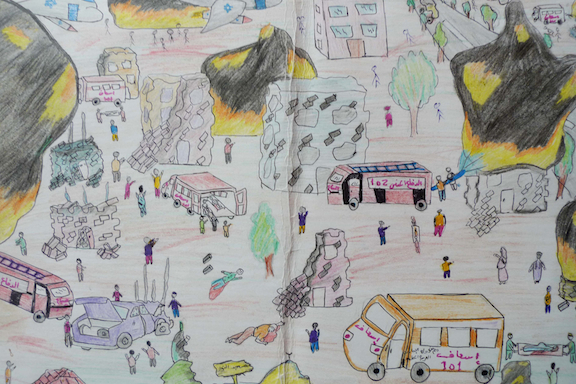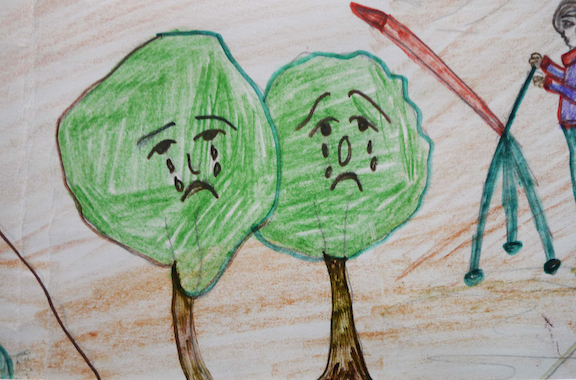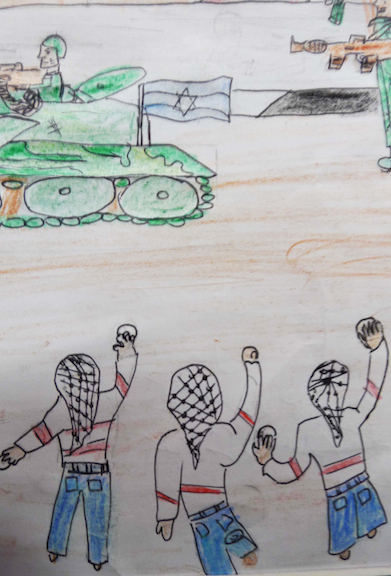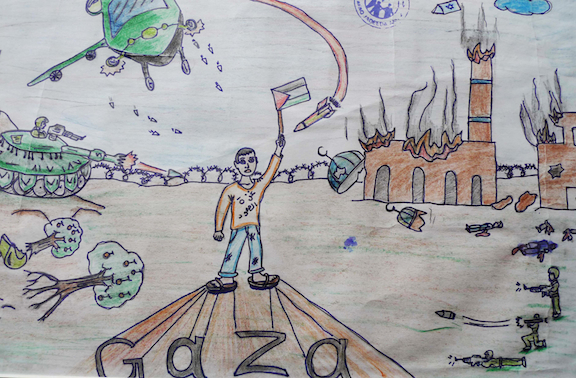A Child’s View from Gaza. 917 Washington Street, Oakland, CA. Currently on view.
A Child’s View from Gaza, a traveling exhibit of the artwork of Palestinian children living in the Gaza Strip, opened in downtown Oakland, California this week as scheduled, despite the fact that the Museum of Children’s Art in Oakland (MOCHA) canceled their agreement to house the project this Fall. After the news on September 8 that Zionist groups had successfully pressured MOCHA’s Board of Directors to cancel their commitment to host the exhibit, local sponsor Middle East Children’s Alliance (MECA) rallied the Bay Area and online community to stand together and “Say No to Censorship!”
According to statements by MOCHA’s Board, the decision came in light of complaints from Jewish groups and calls from other concerned “constituents” who insisted the violence depicted in the artwork was inappropriate for children. However, as MECA founder and executive director Barbara Lubin explained to Electronic Intifada, the incident is by no means an isolated or random instance of censorship: “Anybody who knows this issue knows that the Jewish Federations of North America and the Jewish Council for Public Affairs have launched a multi-million dollar project to combat what they call the ‘delegitmization’ of Israel.” According to Lubin, this campaign works to censor Palestinian cultural initiatives and choke efforts by the boycott, divestment, and sanctions movement, and “what they’re doing is financing the work of silencing and shutting down anyone who wants to talk about what’s really happening to Palestinians.”

[All images on this page from A Child`s View from Gaza. Photographs by Mona Damluji.]
The artwork presented in this collection is part of MECA’s “Let the Children Play & Heal” program, which uses art, music, drama, and storytelling to help children cope with trauma and loss with the support of psychologists, teachers, and trained volunteers. Previously MOCHA has exhibited similar work, for example in collections of the art of Iraqi children after the US invasion and American children’s paintings during World War II. Given its reputation for showing such evocative artwork, the Museum’s sudden vote to cancel the exhibit shocked many in the Oakland community and deeply upset members of the Museum’s staff. One staff member stated that she felt “bullied” into complying with an inexcusable Board decision, which “was not a collective decision.” She went on to share, “I’ve told them if something like this happens again, I will not be working for MOCHA.”
Thanks to an outpouring of local and online community support, the collection of drawings has as of this weekend gone up for public viewing in a vacant storefront around the corner from MOCHA. At the opening of the exhibit, the small room of artwork overflowed with a mixed audience of activists and curious passersby. They gathered to witness perspectives of the world from the point of view of Gaza’s children. MECA Associate Director Ziad Abbas declared to the crowd of visitors flooding the sidewalk outside the entrance: “They tried to stretch the siege from Gaza to Oakland…but they failed!” Next, Barbara Lubin pointed out how the Museum’s flawed decision to cancel the exhibit ultimately brought its message to the attention of the entire world. Lubin elicited further applause when she sang out, “So thank you MOCHA!”
A Child’s View from Gaza features dozens of drawings by Palestinian pupils, using the familiar children’s toolbox of crayons, colored pencils, and felt markers found in a typical classroom anywhere the world. But the dystopic worlds revealed on their paper canvases could only be from the Gaza Strip.

The level of detail some of the children present within a single frame is stunning. Carefully sketched images of bloody limbs, demolished homes, and armed soldiers repeat throughout. The sheer ubiquity of these visual tropes reminds the viewer that these visceral drawings are not only the work of playful imaginations but also reflections of shared and lived experiences.
And yet each child’s hand shares a personal story in unique line and color. Sometimes the depictions are subtle: one picture introduces a touch of every hue in soft pencil strokes, crafting a canvas strewn with simultaneous narratives of all the residents in a single neighborhood. Sometimes they are bold: one drawing fills in the blank paper with bright marks of crayon, zeroing in on a moment when an Israeli soldier corners a child, forced to cower in his own home. In another canvas, even the trees are crying.


In many of the stories these children share, tragedy is met by dignity. One drawing pictures a defiant Palestinian boy standing tall beside a crowd of injured women and children to bravely face the Israeli tanks and soldiers firing at his village. Three figures in blue jeans and kaffiyas leap out of the corner of another frame, fists raised and arms pulled back, prepared to throw rocks at a distant tank. One child places the lone figure of a young man at the center of his devastated landscape. The boy raises his flag to the sky as an Apache helicopter fires overhead. The word “Gaza” radiates across the ground beneath his feet. Another child has scrolled text across the middle of his or her drawing, this time in thick black marker, to say: “We Need Peace.”


A Child’s View from Gaza is a sobering collection, capturing just some of the countless stories of children living under Israel’s relentless occupation and wars. The collection draws in and unsettles onlookers, asking us to bear witness to the consequences of the ongoing siege of the Gaza Strip and imprisonment of its people. Ultimately, the drawings give us no choice but to recognize occupied Palestine’s youngest generation. The attempt to silence their voices has certainly failed, and the Oakland community has made it perfectly clear that censorship of the Palestinian experience is unacceptable.
A Child’s View from Gaza is currently on display at 917 Washington Street in Oakland, CA.